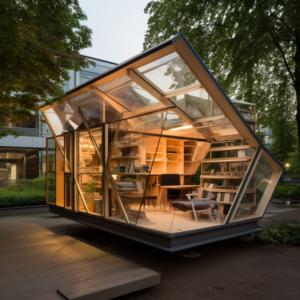Abstract:
In an era marked by rapid environmental shifts and dynamic lifestyle preferences, the concept of “Responsive Dwellings” has emerged as a crucial paradigm in architectural design. This article explores how contemporary architects are integrating responsiveness into residential structures, addressing both environmental challenges and the evolving needs of inhabitants. From climate-responsive designs to flexible interiors, these dwellings embody a holistic approach that adapts to change while prioritizing sustainability, comfort, and well-being.
1. Introduction:
The introduction sets the stage for an exploration of Responsive Dwellings, emphasizing the need for architectural designs that dynamically respond to the challenges posed by environmental changes and evolving lifestyles.
2. Environmental Responsiveness:
This section delves into how architects are incorporating environmental responsiveness into their designs. From passive solar design to rainwater harvesting systems, the article explores strategies that minimize the ecological footprint of dwellings while optimizing energy efficiency.
3. Climate-Adaptive Architecture:
The impact of climate change necessitates architectural solutions that can adapt to varying weather conditions. This section examines how architects are designing responsive dwellings equipped to handle extreme temperatures, natural disasters, and other climatic challenges without compromising on comfort and aesthetics.
4. Smart Technologies for Lifestyle Adaptation:
Technological innovations play a pivotal role in creating responsive dwellings. This section explores how smart home technologies, automation systems, and Internet of Things (IoT) devices are employed to enhance the adaptability of homes to the evolving lifestyles and preferences of residents.
5. Flexible Interiors for Changing Needs:
Responsive dwellings embrace flexible interior designs that can easily adapt to changing needs. This section delves into the use of modular furniture, convertible spaces, and multifunctional layouts that enable residents to customize their living spaces based on their evolving requirements.
6. Biophilic Design and Well-being:
Biophilic design, which connects occupants with nature, contributes to the well-being of residents. This section explores how responsive dwellings integrate natural elements, indoor plants, and ample natural light to create living spaces that enhance mental and physical health.
7. Energy Efficiency and Sustainable Materials:
Energy efficiency and the use of sustainable materials are integral to the responsiveness of modern dwellings. This section examines how architects prioritize environmentally friendly construction materials and energy-efficient systems to create homes that align with principles of sustainability.
8. Accessibility and Inclusivity:
Responsive dwellings are designed with accessibility and inclusivity in mind. This section explores how architects are creating homes that cater to diverse needs, considering factors such as universal design principles, smart home accessibility features, and aging-in-place considerations.
9. Case Studies of Responsive Dwellings:
A series of case studies provides a closer look at exemplary responsive dwellings from around the world. Each case study highlights the unique features, design philosophies, and practical solutions that define these homes as successful examples of architectural responsiveness.
10. Challenges and Solutions:
Creating responsive dwellings comes with its set of challenges, including cost considerations and regulatory hurdles. This section addresses common challenges and explores innovative solutions that architects employ to overcome obstacles associated with designing adaptable and responsive homes.
11. Future Perspectives:
As the concept of responsive dwellings evolves, this section speculates on future perspectives and potential trends. From advancements in green technologies to new materials that enhance adaptability, the article explores the possibilities that lie ahead for the integration of responsiveness into residential architecture.
12. Conclusion:
Responsive Dwellings embody a forward-thinking approach to architecture that not only acknowledges the challenges presented by environmental changes and shifting lifestyles but actively seeks solutions to address them. By seamlessly integrating environmental responsiveness, technological innovation, and flexible design principles, these dwellings pave the way for a more sustainable, adaptable, and harmonious living environment. In the face of an ever-changing world, the concept of Responsive Dwellings emerges as a beacon of resilience and foresight in architectural design.



